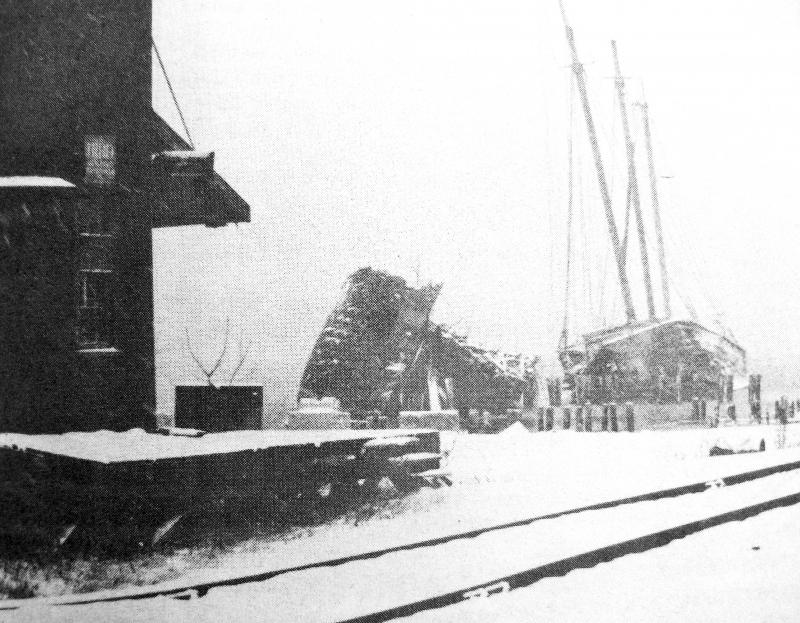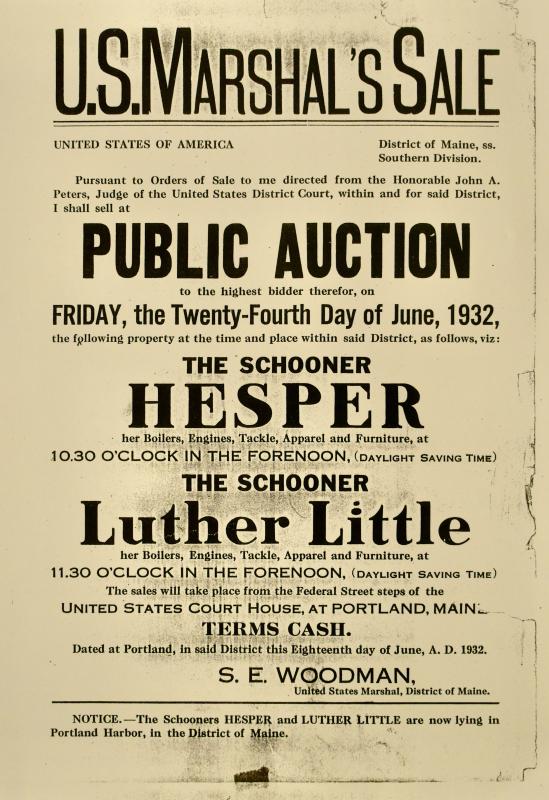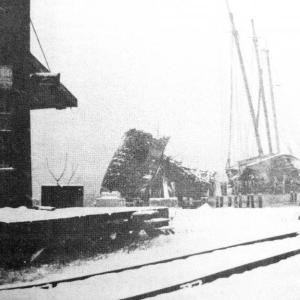Wiscasset’s most photographed ships
Years ago, I took the picture you see here showing Wiscasset’s once famous schooners, the Hesper on the left, and Luther Little on the right. The old ships as you probably know were broken up and hauled away years ago. They continue to be fondly remembered by an older generation, although remain largely unknown to those born after 1990.
This picture caught my attention because it was taken in 1980 when the ships still remained pretty much intact. It was a bitterly cold morning, a stiff breeze was blowing off the river, and as you can see it was snowing pretty heavily. The building that’s shown on the left like the old ships has also disappeared. It was a two-story wooden warehouse owned by Wiscasset Lumber Company. The Sherman brothers, Walter, Stan and Gerry Sherman, owned the lumber company. Their showroom and store were on Water Street.
They have all since passed away. The wooden platform alongside the railroad served as a loading dock during the days when lumber and other building materials were delivered by train. The tracks here were part of a siding that was removed during the construction of the Davey Bridge in the 1980s. This building was the tallest one on the waterfront and had once housed Turner Centre Creamery. It was raised to make room for construction of the Creamery Pier, where Sprague’s Lobster is now located. In 2014, the Wiscasset, Waterville & Farmington Railway Museum based in Alna unveiled a miniature model of the buildings located here showing how they might have looked in the 1920s.
When I took the picture, the Luther Little still had three of its four masts. The summer before, an Earth tremor of all things had caused the rear mast which had been leaning stern-wise to come crashing down on her deck. Around this same time there had been an ongoing attempt to save the old schooners but by the winter of 1981 folks had given up hopes of preserving them and the old ships were left to the mercy of Mother Nature.
When people saw the ships for the first time what surprised them the most was hearing about their age. Most people believed them to be much older than they actually were. Both were built and launched in the early 20th century, the Luther Little in 1917, the Hesper in 1918. They’d been left abandoned on the Wiscasset waterfront since the 1930s and by the 1970s anything left onboard them of any value had long since been pilfered. Left to the elements their hulls and decking had grayed, blackened and warped over the years.
Both had once been used as merchant ships and in fact equipped with a few modern conveniences. Each had coal-fired steam boilers and small engines that were used for powering the capstan, raising the sails and hoisting the anchors. The boiler also provided steam heat and hot water for the cabins.
The Luther Little gained national attention in June 1918 when her crew rescued two balloonists, Arthur R Houghton and Edward B. Packard off the coast of Delaware. After lifting off from Cape May, New Jersey the balloonists ran into trouble and came crashing down into the ocean. The crew of the Luther Little spotted the balloon and came to their rescue. Not only did they save the pilots, they also were able to salvage the balloon. The Hesper built in Somerset, Massachusetts was a little larger than the Luther Little. Among her early voyages was an Atlantic crossing carrying a load of coal to Lisbon, Spain. The Hesper like the Luther Little turned a profit for her owners into the 1920s before both vessels lost out to faster, more reliable fuel-driven ships.
In June 1932 both the Luther Little and Hesper were auctioned off in a U.S. Marshal’s sale held to satisfy financial claims against their owners. Both were bought by an Auburn businessman, Frank W. Winter, owner of the Wiscasset, Waterville & Farmington Railroad. He planned to carry timber harvested in northern Maine over his narrow-gauge railroad to Wiscasset harbor where they’d be taken by the two ships to markets in New York and Boston. Winter had both ships towed from Portland to Wiscasset but never used them. Around 1936 both ships were pulled ashore to their final resting place.
People who saw the ships often wondered what happened to the Hesper’s four missing masts. As the story goes, sometime in the 1940s they were cut down by a Portland salvage company. The same company carted off the ship’s windlass and steam engine.
Some folks say the old Wiscasset schooners were the most photographed ships in the world. Maybe there weren’t many people driving through Wiscasset in the 1940s, 50s, 60s and 70s that could resist stopping at the waterfront and taking a few pictures of them. Me included.
Phil Di Vece earned a B.A. in journalism studies from Colorado State University and a M.A. in journalism at the University of South Florida. He is the author of three Wiscasset books and is a frequent news contributor to the Wiscasset Newspaper and Boothbay Register. He resides in Wiscasset. Contact him at pdivece@roadrunner.com

































